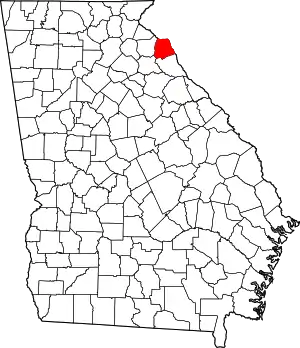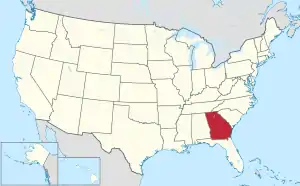Hart County, Georgia
Hart County is a county located in the northeastern part of the U.S. state of Georgia. As of the 2010 census, the population was 25,213.[1] The county seat is Hartwell.[2]
Hart County | |
|---|---|
 J. Pearl Jones House, completed in 1914. Greek Revival architecture. | |
 Location within the U.S. state of Georgia | |
 Georgia's location within the U.S. | |
| Coordinates: 34°21′N 82°58′W | |
| Country | |
| State | |
| Founded | December 7, 1853 |
| Named for | Nancy Hart |
| Seat | Hartwell |
| Largest city | Hartwell |
| Area | |
| • Total | 257 sq mi (670 km2) |
| • Land | 232 sq mi (600 km2) |
| • Water | 25 sq mi (60 km2) 9.6%% |
| Population | |
| • Estimate (2018) | 26,018 |
| • Density | 108/sq mi (42/km2) |
| Time zone | UTC−5 (Eastern) |
| • Summer (DST) | UTC−4 (EDT) |
| Congressional district | 9th |
| Website | www |
Hart County was created December 7, 1853 and named for Nancy Hart. Of Georgia's 159 counties, Hart County is the only one named after a woman. Lake Hartwell is also named for her.[3]
Letters to Miss Celie in the movie The Color Purple (film) by Steven Spielberg, based on the novel The Color Purple by Alice Walker, are addressed to "Hartwell County, Georgia" suggesting that the movie is set either in Hartwell or Hart County.
Geography
According to the U.S. Census Bureau, the county has a total area of 257 square miles (670 km2), of which 232 square miles (600 km2) is land and 25 square miles (65 km2) (9.6%) is water.[4] The county is located in the Piedmont region of the state.
Most of the southern three-quarters of Hart County is located in the Upper Savannah River sub-basin of the larger Savannah River basin, with the exception of two slivers of the county, south of Royston and west of Bowersville, which are located in the Broad River sub-basin of the Savannah River basin. The northern quarter of the county is located in the Tugaloo River sub-basin of the same Savannah River basin.[5]
Major highways
 Interstate 85
Interstate 85 U.S. Route 29
U.S. Route 29 State Route 8
State Route 8 State Route 17
State Route 17 State Route 51
State Route 51 State Route 59
State Route 59 State Route 77
State Route 77 State Route 77 Connector
State Route 77 Connector State Route 77 Spur
State Route 77 Spur State Route 172
State Route 172 State Route 180
State Route 180 State Route 281
State Route 281 State Route 403 (unsigned designation for I-85)
State Route 403 (unsigned designation for I-85)
Adjacent counties
- Oconee County, South Carolina (north)
- Anderson County, South Carolina (northeast)
- Elbert County (south)
- Madison County (southwest)
- Franklin County (west)
Demographics
| Historical population | |||
|---|---|---|---|
| Census | Pop. | %± | |
| 1860 | 6,137 | — | |
| 1870 | 6,783 | 10.5% | |
| 1880 | 9,094 | 34.1% | |
| 1890 | 10,887 | 19.7% | |
| 1900 | 14,492 | 33.1% | |
| 1910 | 16,216 | 11.9% | |
| 1920 | 17,944 | 10.7% | |
| 1930 | 15,174 | −15.4% | |
| 1940 | 15,512 | 2.2% | |
| 1950 | 14,495 | −6.6% | |
| 1960 | 15,229 | 5.1% | |
| 1970 | 15,814 | 3.8% | |
| 1980 | 18,585 | 17.5% | |
| 1990 | 19,712 | 6.1% | |
| 2000 | 22,997 | 16.7% | |
| 2010 | 25,213 | 9.6% | |
| 2018 (est.) | 26,018 | [6] | 3.2% |
| U.S. Decennial Census[7] 1790-1960[8] 1900-1990[9] 1990-2000[10] 2010-2013[1] | |||
2000 census
As of the census[11] of 2000, there were 22,997 people, 9,106 households, and 6,610 families living in the county. The population density was 99 people per square mile (38/km2). There were 11,111 housing units at an average density of 48 per square mile (18/km2). The racial makeup of the county was 79.09% White, 19.36% Black or African American, 0.15% Native American, 0.53% Asian, 0.24% from other races, and 0.63% from two or more races. 0.85% of the population were Hispanic or Latino of any race.
There were 9,106 households, out of which 29.00% had children under the age of 18 living with them, 56.80% were married couples living together, 12.00% had a female householder with no husband present, and 27.40% were non-families. 24.40% of all households were made up of individuals, and 10.60% had someone living alone who was 65 years of age or older. The average household size was 2.47 and the average family size was 2.92.
In the county, the population was spread out, with 23.50% under the age of 18, 7.70% from 18 to 24, 27.30% from 25 to 44, 25.00% from 45 to 64, and 16.50% who were 65 years of age or older. The median age was 39 years. For every 100 females there were 97.00 males. For every 100 females age 18 and over, there were 92.70 males.
The median income for a household in the county was $32,833, and the median income for a family was $39,600. Males had a median income of $30,652 versus $21,233 for females. The per capita income for the county was $16,714. About 12.20% of families and 14.80% of the population were below the poverty line, including 19.10% of those under age 18 and 16.50% of those age 65 or over.
2010 census
As of the 2010 United States Census, there were 25,213 people, 10,121 households, and 6,998 families living in the county.[12] The population density was 108.5 inhabitants per square mile (41.9/km2). There were 13,007 housing units at an average density of 56.0 per square mile (21.6/km2).[13] The racial makeup of the county was 77.4% white, 18.7% black or African American, 0.9% Asian, 0.1% American Indian, 1.7% from other races, and 1.3% from two or more races. Those of Hispanic or Latino origin made up 3.1% of the population.[12] In terms of ancestry, 13.6% were American, 8.4% were English, 7.4% were Irish, and 6.6% were German.[14]
Of the 10,121 households, 30.7% had children under the age of 18 living with them, 51.1% were married couples living together, 13.6% had a female householder with no husband present, 30.9% were non-families, and 27.4% of all households were made up of individuals. The average household size was 2.43 and the average family size was 2.94. The median age was 42.6 years.[12]
The median income for a household in the county was $36,109 and the median income for a family was $44,451. Males had a median income of $35,172 versus $26,836 for females. The per capita income for the county was $19,124. About 17.4% of families and 22.4% of the population were below the poverty line, including 30.4% of those under age 18 and 13.4% of those age 65 or over.[15]
Attractions
- Lake Hartwell, a man-made lake covering 56,000 acres built for flood control and recreation
- The Scarecrow festival occurs in Hartwell every year during the month of October. This is when the downtown gets "invaded" by scarecrows, which are handmade scarecrows placed in front of local shops and businesses.
- Cateechee is one of the state's finest golf courses. It has 380 acres of land and 18 holes.
- The Hartwell Dam is the county's largest generator of electricity, supplying power to more than 10 states. It can be seen at the Georgia and South Carolina border or U.S. Route 29. Usually power is generated daily and a long fog horn is heard all around the dam before they start generating.
Communities
City
Town
Census-designated places
Other unincorporated communities
Politics
| Year | Republican | Democratic | Third parties |
|---|---|---|---|
| 2020 | 74.4% 9,464 | 24.8% 3,157 | 0.8% 106 |
| 2016 | 72.0% 7,286 | 25.6% 2,585 | 2.4% 246 |
| 2012 | 68.4% 6,517 | 30.1% 2,870 | 1.5% 142 |
| 2008 | 65.2% 6,537 | 33.6% 3,365 | 1.2% 122 |
| 2004 | 60.9% 5,500 | 38.5% 3,479 | 0.6% 53 |
| 2000 | 56.3% 4,242 | 42.4% 3,192 | 1.4% 102 |
| 1996 | 40.2% 2,884 | 48.6% 3,486 | 11.2% 801 |
| 1992 | 34.3% 2,607 | 47.5% 3,614 | 18.2% 1388 |
| 1988 | 54.9% 3,044 | 44.6% 2,476 | 0.5% 27 |
| 1984 | 53.2% 2,842 | 46.8% 2,496 | |
| 1980 | 25.4% 1,577 | 73.0% 4,539 | 1.6% 99 |
| 1976 | 15.7% 860 | 84.3% 4,605 | |
| 1972 | 74.6% 2,308 | 25.4% 784 | |
| 1968 | 12.3% 586 | 20.5% 980 | 67.2% 3,208 |
| 1964 | 27.0% 1,166 | 72.8% 3,142 | 0.2% 10 |
| 1960 | 6.5% 275 | 93.5% 3,963 | |
| 1956 | 8.6% 107 | 91.4% 1,139 | |
| 1952 | 5.9% 204 | 94.1% 3,244 | |
| 1948 | 5.1% 78 | 89.1% 1,363 | 5.8% 89 |
| 1944 | 13.6% 183 | 86.4% 1,161 | |
| 1940 | 6.7% 97 | 92.2% 1,328 | 1.1% 16 |
| 1936 | 12.8% 222 | 87.0% 1,514 | 0.3% 5 |
| 1932 | 0.9% 12 | 99.0% 1,261 | 0.1% 1 |
| 1928 | 39.6% 603 | 60.4% 919 | |
| 1924 | 5.8% 65 | 76.7% 857 | 17.5% 195 |
| 1920 | 31.8% 323 | 68.2% 694 | |
| 1916 | 23.5% 237 | 74.3% 750 | 2.2% 22 |
| 1912 | 35.5% 259 | 63.0% 459 | 1.5% 11 |
References
- "State & County QuickFacts". United States Census Bureau. Archived from the original on June 7, 2011. Retrieved February 16, 2014.
- "Find a County". National Association of Counties. Retrieved June 7, 2011.
- "Hart County". Georgia.gov. Retrieved March 20, 2018.
- "US Gazetteer files: 2010, 2000, and 1990". United States Census Bureau. February 12, 2011. Retrieved April 23, 2011.
- "Georgia Soil and Water Conservation Commission Interactive Mapping Experience". Georgia Soil and Water Conservation Commission. Retrieved November 18, 2015.
- "Population and Housing Unit Estimates". Retrieved July 31, 2019.
- "U.S. Decennial Census". United States Census Bureau. Retrieved June 23, 2014.
- "Historical Census Browser". University of Virginia Library. Retrieved June 23, 2014.
- "Population of Counties by Decennial Census: 1900 to 1990". United States Census Bureau. Retrieved June 23, 2014.
- "Census 2000 PHC-T-4. Ranking Tables for Counties: 1990 and 2000" (PDF). United States Census Bureau. Retrieved June 23, 2014.
- "U.S. Census website". United States Census Bureau. Retrieved May 14, 2011.
- "DP-1 Profile of General Population and Housing Characteristics: 2010 Demographic Profile Data". United States Census Bureau. Archived from the original on February 13, 2020. Retrieved December 29, 2015.
- "Population, Housing Units, Area, and Density: 2010 - County". United States Census Bureau. Archived from the original on February 13, 2020. Retrieved December 29, 2015.
- "DP02 SELECTED SOCIAL CHARACTERISTICS IN THE UNITED STATES – 2006-2010 American Community Survey 5-Year Estimates". United States Census Bureau. Archived from the original on February 13, 2020. Retrieved December 29, 2015.
- "DP03 SELECTED ECONOMIC CHARACTERISTICS – 2006-2010 American Community Survey 5-Year Estimates". United States Census Bureau. Archived from the original on February 13, 2020. Retrieved December 29, 2015.
- Leip, David. "Dave Leip's Atlas of U.S. Presidential Elections". uselectionatlas.org. Retrieved March 20, 2018.
External links
- Hart County historical marker
- Parkertown 1832 historical marker
